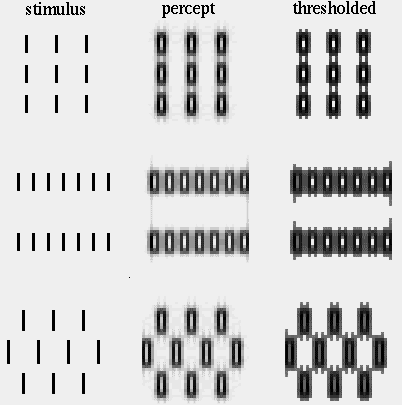
A radically new and different idea can hardly avoid colliding with established dogmas. And that is indeed what occurred with this thesis. By the time my "advisors" were through with it, I hardly even wanted my name on it any more! So I kept an earlier version of the thesis around, to represent the thesis that I would have written, if it had been up to me. That is the thesis you see here.
It is a bit "rough around the edges", since it was partially reconstructed after the fact from older versions I had lying around, and it never received the intensive scrutiny to which the "official" version was subjected. Nevertheless it contains a number of interesting insights which are all but obscured in the "official" version.
The major differences between this thesis and the official version are listed below.
Stephen Grossberg insisted that I include the words "Neural Network" in the title, to suggest that this is a neural network model. The first part on "Directed Diffusion model" might be construed very broadly as a neural network model, but the main thrust of the whole thesis, especially the second, more important "Orientational Harmonics" section, is on the limitations of neural network theory, and on the necessity to formulate more fine-grained analog field-like diffusive processes to account for the Gestalt aspects of perception.
A number of constructive and respectful criticisms of the limitations of the BCS model were eliminated from the official version. Particularly the discussion of the problem of spatial averaging for very large receptive fields, which, in my view, is the Achilles heel of Grossberg's model.
In both the Directed Diffusion, and Orientational Harmonic models, I propose that oriented edge signals diffuse outward in collinear fashion from a detected edge, as an explanation of collinear illusory contour formation. Grossberg objects to outward diffusion because illusory contours are observed to form only inwards between pairs of oriented edges. In Grossberg's neural receptive field model this is handled by a "conjunctive constraint" (my terminology) that allows the cooperative cell to respond only if it receives input from both lobes of its bipolar receptive field simultaneously. In my diffusion models this conjunctive constraint is handled as a global emergent property of the local interactions between individual small scale filters. Grossberg does not accept this principle, and consequently he objects to my outward diffusion. He insisted therefore that I re-do all of my computer simulations, and present each result in tandem, first without, and then with the threshold applied. For example the left column below shows three stimulus configurations, and the center column shows the three percepts computed by the model. The right column shows those same simulation results with a sharp threshold applied, which Grossberg considers to be the valid output of my model.Besides the fact that the thresholded outputs show no resemblance to the phenomenon they supposedly model, this really confused the presentation because the captions were the same for the figures with and without threshold, although they only describe MY output correctly, so the captions on Grossberg's figures often did not even match the figure they described! But in fact the Directed Diffusion model is merely a directed version of Grossberg's own diffusion model in the Feature Contour System (FCS) (Grossberg & Todorovicz 1988) which was my original inspiration for directed diffusion, so if my model needed a threshold, then the same kind of threshold would have to be applied in his FCS model, where no such threshold is applied, as I pointed out in my thesis defense. 
Chapter 4 on Higher Level Representation of Visual Information was removed entirely, although in my view this is one of the most interesting implications of the Harmonic Resonance theory, as I discuss in my Harmonic Resonance paper.